








Analyzing Power Consumption of Bluetooth Speakers: A Comprehensive Guide
In today's fast-paced world, where music is an integral part of our daily lives, Bluetooth speakers offer the flexibility to enjoy tunes on the go. However, have you ever wondered how much power these seemingly innocuous devices consume? Understanding the power consumption of Bluetooth speakers can not only help you make informed purchasing decisions but also enhance your overall experience. In this comprehensive guide, we'll dive into the intricacies of Bluetooth speaker power consumption, analyzing the factors that affect it and offering practical tips for optimizing your usage.
Understanding Power Consumption
Power consumption, in simple terms, refers to the amount of energy a device uses over a specific period. It's typically measured in watts (W). The lower the wattage, the less energy the device consumes. For Bluetooth speakers, this measurement is crucial because it impacts how long you can use the speaker before needing to recharge it. Think of power consumption as the fuel efficiency of your car; just like you want a car that goes further on less gas, you want a Bluetooth speaker that delivers more sound for less energy.
Factors Influencing Power Consumption
Several factors influence the power consumption of Bluetooth speakers, including:
1. **Volume Level**: Just like a car engine revs harder when you accelerate, your Bluetooth speaker works harder—and consumes more power—at higher volume levels. If you often crank up the volume for a party, you will notice a quicker drain on the battery.
2. **Bluetooth Version**: The Bluetooth technology itself plays a significant role. Newer versions, such as Bluetooth 5.0, are designed to be more energy-efficient compared to their predecessors. If you're using an older speaker, consider upgrading to a model that supports the latest Bluetooth technology.
3. **Audio Quality Settings**: Many speakers come with various audio settings that can enhance sound quality but also increase power consumption. High-definition audio, for example, requires more power than standard audio.
4. **Additional Features**: Features such as LED lights, built-in voice assistants, and even subwoofers can contribute to higher power usage. While these features enhance the listening experience, they also draw power, much like a car's air conditioning unit reduces fuel efficiency.
Measuring Power Consumption
To accurately measure the power consumption of your Bluetooth speaker, you can use a power meter. This handy device plugs into your power outlet, and you can then plug your speaker into it. The meter will provide you with real-time data on how much power your speaker is consuming while in use, as well as when it's charging.
But what if you don't want to invest in a power meter? You can also refer to the manufacturer's specifications, which usually include the average power consumption in watts. Keep in mind that these are often based on optimal conditions, so real-world usage may vary.
Optimizing Power Consumption
Now that you understand the factors affecting power consumption, let's discuss ways to optimize it:
1. **Adjust Volume**: Keeping the volume at a moderate level not only protects your hearing but also prolongs the battery life of your speaker. Think of it as cruising at a steady speed rather than racing; your fuel (or battery) lasts longer.
2. **Turn Off When Not in Use**: It may sound obvious, but turning off your speaker when you're not using it can save a significant amount of battery life. Some speakers come with automatic shut-off features, which can be a lifesaver.
3. **Use Energy-Efficient Settings**: If your Bluetooth speaker has an eco-mode or energy-saving settings, use them! These settings usually adjust audio quality and volume to minimize power usage.
4. **Keep Firmware Updated**: Manufacturers often release firmware updates that can improve the performance and energy efficiency of your device. Make it a habit to check for updates regularly.
Conclusion
Understanding the power consumption of Bluetooth speakers is essential for anyone looking to maximize their listening experience while being mindful of energy use. By considering factors like volume, Bluetooth version, and additional features, you can make informed choices that enhance your enjoyment without draining your battery. Remember, just like maintaining a car ensures its longevity, optimizing your Bluetooth speaker usage will lead to more enjoyable sound experiences for years to come.
FAQs
1. How long can I expect my Bluetooth speaker to last on a full charge?
Battery life can vary widely depending on the speaker model and usage. Generally, you can expect anywhere from 5 to 20 hours of playback on a full charge.
2. Does using a Bluetooth speaker while charging affect its power consumption?
Using a Bluetooth speaker while it's charging will typically increase power consumption, but modern speakers are designed to manage this efficiently. However, it's best to avoid heavy usage during charging to prolong battery lifespan.
3. Can I extend the battery life of my Bluetooth speaker?
Yes! You can extend the battery life by keeping the volume at moderate levels, turning off features you don't use, and storing the speaker in a cool, dry place when not in use.
